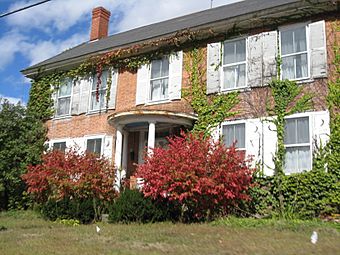Spring Hill Farm (Lebanon, New Hampshire) facts for kids
Quick facts for kids |
|
|
Spring Hill Farm
|
|
 |
|
| Lua error in Module:Location_map at line 420: attempt to index field 'wikibase' (a nil value). | |
| Location | 263 Meriden Rd., Lebanon, New Hampshire |
|---|---|
| Area | 91.5 acres (37.0 ha) |
| Built | 1799 |
| Built by | Downes, Maurice |
| Architectural style | Federal, Colonial Revival |
| NRHP reference No. | 02000639 |
| Added to NRHP | June 13, 2002 |
Spring Hill Farm is a very old farm in Lebanon, New Hampshire. It is located at 263 Meriden Road. This farm is special because of new ideas in dairy farming. A man named Maurice Downes brought these ideas in the 1920s.
The farm is one of the few old farms still left in Lebanon. It was added to a list of important places in 2002. This list is called the National Register of Historic Places.
What Does Spring Hill Farm Look Like?
Spring Hill Farm is in a countryside area of Lebanon. It covers about 91.5 acres. This is like having 69 football fields! Roads surround the farm on its south and west sides.
The farm has several buildings close together. There is a main house and a barn. There are also other smaller buildings. The main house is made of brick. It has two and a half stories. It was built around the year 1799.
The barn was built around 1929. But it uses parts from older barns. Some of its wood came from barns built in the early 1800s. Most of the farm's land is covered in woods. Only the areas right around the buildings are open fields.
Who Was Maurice Downes?
Maurice Downes bought Spring Hill Farm in 1913. He was from Wilmot, New Hampshire. When he bought the farm, it had the main house. It also had three barns from the 1800s. These were called English barns.
Maurice Downes studied farming at the University of New Hampshire. He learned many new ways to farm. He wanted to make dairy farming better.
New Ideas for Dairy Farming
Maurice Downes brought a special type of cow to the area. These were Holstein cows. Holstein cows produce a lot of milk. Because of him, they are now the main type of milk cow in the region.
In the 1920s, he made big changes to one of his barns. He wanted to do all the dairy work in one building. He made the barn bigger. He used materials from the other two old barns. He took them apart and reused the wood.
His new barn had a concrete floor. It also had a special system to remove manure. This system used a trolley that moved the manure outside. These ideas were very new and helpful for farms in the area.

